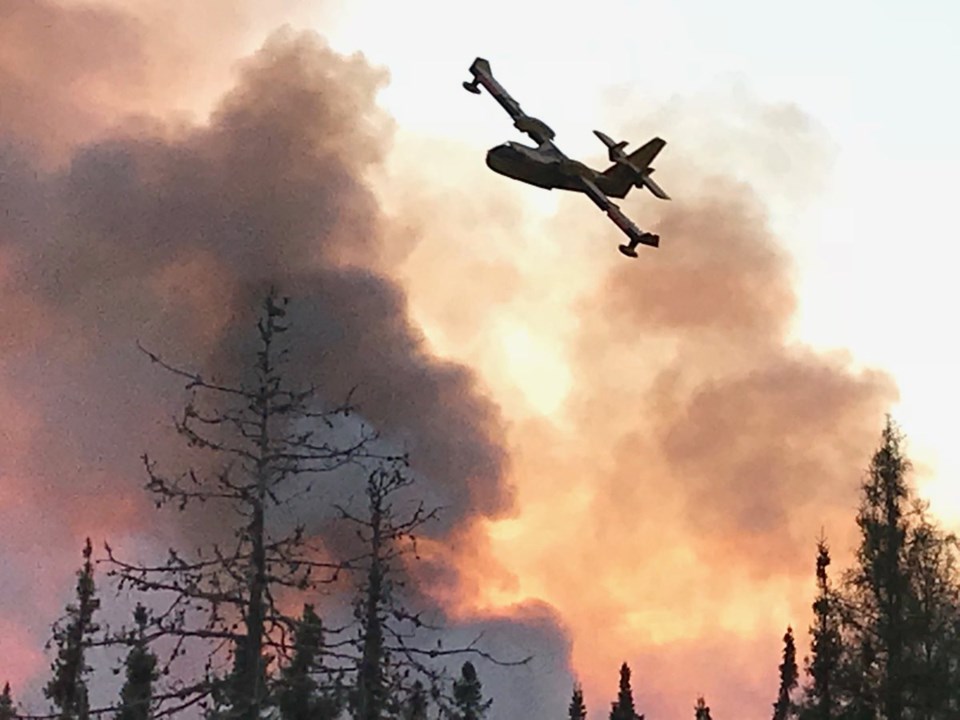Rainfall recorded across Northwestern Ontario has helped buy time for crews fighting forest fires menacing several communities, but it will take more precipitation to overcome drought conditions, authorities say.
Ontario’s Aviation, Forest Fire and Emergency Services (AFFES) reported 119 active fires across the Northwest as of Thursday evening, with 18 listed as not under control, nine as being held, 13 as under control, and 79 as being observed.
A fire known as Kenora 51 was described as a “massive” by AFFES fire information officer Chris Marchand, mapped at 197,547 hectares.
The fire has burned to the northern shore of Umfreville Lake, remaining about 20 kilometres north of Wabaseemoong Independent Nations, prompting the First Nation to declare a state of emergency Tuesday and begin evacuating vulnerable members.
Around 200 people had evacuated as of mid-day Friday, reported Ontario's Ministry of the Solicitor General, with plans to evacuate more underway.
The fire has not yet been able to gain a foothold on the southern side of the lake, closer to the community, though Marchand didn’t rule out that possibility.
“It has almost a two-kilometre span of water to cross to advance southwards, and that’s not an unheard-of thing.”
Large, aggressively-burning fires can send embers farther than two kilometres, creating spot fires, he said.
Wabaseemoong Chief Waylon Scott said on social media Thursday that every house in the community should have sprinklers set up by Saturday, and a buffer zone had been established around the school
The First Nation, located about 120 kilometres northwest of Kenora, began a partial evacuation on Wednesday, with evacuees hosted in locations including Kenora, Dryden, Manitoba, and London.
“It wasn’t an easy decision to make, but let’s please leave the community for our safety and allow MNRF to freely do their job to protect our beautiful community,” he urged members on Thursday.
Numerous crews, water bombers, and heavy equipment are fighting the fire.
Also on Thursday, AFFES received encouraging rainfall numbers across the far north, including in the area of fires near several communities.
Over 20 millimetres were recorded in Poplar Hill, where the Red Lake 65 fire burns around six kilometres west.
Around 15 millimetres fell in Deer Lake. Red Lake 51 was burning at 52,106 hectares 24 kilometres west of the community.
Similar amounts were recorded near the town of Red Lake, where Red Lake 77 was burning at 27,899 hectares about 33 kilometres to the west.
Crews continued to establish hose lines along the northeast edge of the fire, AFFES reported, with helicopters and additional crews assisting.
Rainfall had decreased fire behaviour in the area, Marchand said.
It will take more rainfall to make a dent in fires like Kenora 51, however.
“This certainly isn’t enough rain to get us out of our overriding predicament, which is the drought conditions that are keeping the northwest fairly receptive to new lightning fires,” he said. “But it’s a reprieve from the more intense fire behaviour that’s going to help buy us some more time.”
In the wake of rainfall, higher humidity and lower temperatures were also expected to help limit fire behaviour.
The wildland fire hazard in the Northwest was mainly low Friday, with areas of moderate to high hazard persisting in the Fort Frances, Dryden, and Thunder Bay sectors.
Restrictions remain in place across the region due to the fire hazard.
A restricted fire zone imposed by the province in July remains in effect in the Kenora, Fort Frances, Dryden and Thunder Bay districts, and parts of the Sioux Lookout, Red Lake, Nipigon, and Wawa districts, with outdoor burning banned.
Implementation orders also restrict access to parts of the Kenora and Red Lake districts. Visit ontario.ca/forestfire for more information.
Two new fires were discovered in the northwest region on Thursday, including Fort Frances 120, located near Argo Lake amid a large cluster of fires in Quetico Provincial Park. The 27 hectare fire is being observed.
